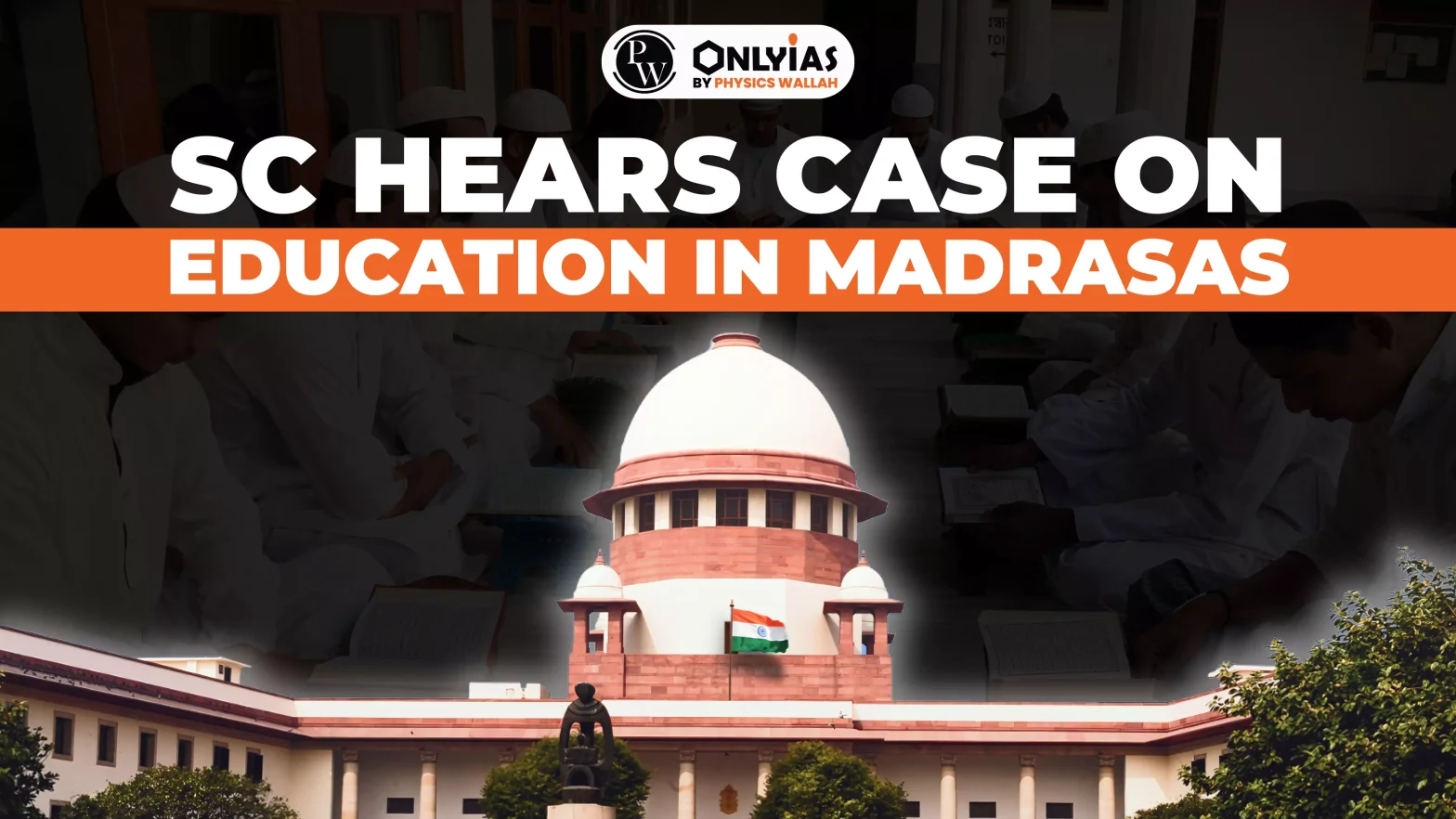The Supreme Court is currently reviewing the legal status of madrasas in India, focusing on their educational standards and funding. This comes in response to concerns raised by the National Commission for Protection of Child Rights regarding compliance with the Right to Education Act.
Background
- On March 22, the Allahabad High Court ruled the Uttar Pradesh Board of Madarsa Education Act unconstitutional, citing that the education provided violates the principle of secularism by promoting Islamic supremacy.
- The court argued this goes against the fundamental right to equality under Article 14 of the Indian Constitution, as students in unrecognised madrasas do not receive comprehensive education like their counterparts in subjects such as Science and Social Studies (SST), which contribute to all-round development.
- The court also ordered the state government to merge students from unrecognised madrasas or the ones recognised under UP primary, high school, and intermediate education boards into recognised schools.
- In response, the Uttar Pradesh government defended the madrasa board, stating that it provides religious education, which is allowed under the Constitution, and the government is facilitating it based on constitutional provisions.
- This decision has prompted the Supreme Court to examine the legal status of madrasas and their adherence to educational standards. The Supreme Court has put a stay on the Allahabad High Court’s ruling until further hearings are conducted.
Enroll now for UPSC Online Course
National Commission for Protection of Child Rights (NCPCR) View on Madrasas
- The National Commission for Protection of Child Rights (NCPCR) has argued that the education provided in madrasas is not comprehensive and does not align with the standards set by the Right to Education (RTE) Act. .
- They highlighted this system violates the provisions given under (RTE) Act such as focus on overall development, proper infrastructure, appropriate student-teacher ratio.
- Additionally, the NCPCR has raised concerns that madrasa curricula promote a singular religious perspective, which they believe undermines the principles of secular education and children’s rights to inclusive and diverse learning environments.
What are Madrasas?
- Madrasa, derived from the Arabic word for “educational institution,” has a long and evolving history.
- Initially, mosques served as both places of worship and centres for learning. By the 10th century, madrasas became distinct institutions dedicated to both religious and secular education, primarily within the Islamic world.
- Early evidence of such schools comes from regions like Khorasan and Transoxania, encompassing parts of modern-day Iran, Central Asia, and Afghanistan.
- In their early form, large madrasas often provided housing for students, particularly those from disadvantaged backgrounds.
Madrasas in India
- As of the 2018-19 academic year, India had approximately 24,010 madrasas, with around 19,132 recognized by state boards and 4,878 unrecognised. Recognized madrasas are under state boards for madrasa education, while unrecognised ones follow curricula prescribed by larger seminaries such as Darul Uloom Nadwatul Ulama (Lucknow) and Darul Uloom Deoband.
- The majority of these institutions—about 60%—are located in Uttar Pradesh, with 11,621 recognized and 2,907 unrecognised madrasas. Rajasthan follows with 2,464 recognized madrasas. Interestingly, several states and Union Territories, including Delhi and Tamil Nadu, have no recognized madrasas.
Categories of Madrasas
Madrasas in India are broadly categorised into two types:
- Madrasa Darse Nizami: These operate as public charities and are not bound by state educational curricula. Their focus is primarily on religious education, often in Arabic, Urdu, or Persian.
- Madrasa Darse Aliya: These are affiliated with state madrasa education boards and follow state-prescribed curricula. In these madrasas, the state government appoints teachers, and the institutions are regulated by the respective state governments.
Check Out UPSC CSE Books From PW Store
In 2023, around 1.69 lakh students appeared for the Uttar Pradesh madrasa education board examinations, which are equivalent to Class 10 and Class 12. Similar to madrasa boards, some states like Uttar Pradesh also have separate Sanskrit boards.
Madrasa education parallels traditional school systems, with students progressing through levels equivalent to:
- Maulvi: Class 10
- Alim: Class 12
- Kamil: Bachelor’s degree
- Fazil: Master’s degree
In Darse Nizami madrasas, the medium of instruction is typically Arabic, Urdu, and Persian, whereas Darse Aliya madrasas incorporate state or NCERT (National Council of Educational Research and Training) textbooks. Many madrasa boards now include NCERT curricula, with compulsory subjects such as Mathematics, Science, Hindi, and English, along with optional papers like Sanskrit or Deeniyat (religious studies including the Quran).
Funding Sources
Madrasas receive their primary funding from state governments. The central government also contributes through the Scheme for Providing Education to Madrasas/Minorities (SPEMM), which offers financial support through two sub-schemes:
- Scheme for Providing Quality Education in Madrasas (SPQEM): Funding is provided for quality education.
- Infrastructure Development of Minority Institutes (IDMI): Focuses on infrastructure development for madrasas.
In 2021, the administration of SPEMM was transferred from the Ministry of Minority Affairs to the Ministry of Education.
Enroll now for UPSC Online Classes
Conclusion
The ongoing legal scrutiny of madrasas emphasises the need for balancing religious education with comprehensive academic standards to ensure alignment with the Right to Education Act. A collaborative dialogue between the government and stakeholders is essential to address these concerns while respecting constitutional provisions.
![]() 20 Sep 2024
20 Sep 2024

